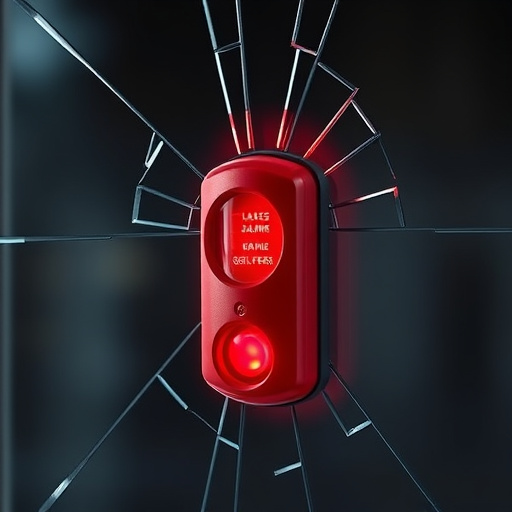Glass break alarm sensors, utilizing acoustic technology, detect minor fractures through sound wave changes, triggering immediate security alerts. After a thorough security assessment by professionals who strategically place sensors based on window placement, material, and potential hiding spots, these sensors connect to a central control panel for remote monitoring. Sensitivity levels can be adjusted to prevent false alarms. Installation involves wiring sensors to the control panel and customizing settings through an intuitive interface; post-installation testing and regular maintenance ensure optimal performance.
“Enhance your home or business security with a glass break alarm system – a powerful tool against unauthorized access. This comprehensive guide delves into the installation process of these advanced sensors, offering peace of mind and real-time alerts. From understanding the technology behind glass break alarms to post-installation care, we cover it all. Learn how to prepare, choose optimal sensor locations, follow step-by-step installation instructions, and maintain your system for maximum effectiveness.”
Understanding Glass Break Alarm Sensors: How They Work
Glass break alarm sensors are designed to detect and respond to the unique acoustic signature of broken glass, providing an immediate security alert. These sensors work by transmitting and receiving sound waves through the glass pane. When the glass is broken, the sensor picks up the sudden change in the sound pattern, which triggers the alarm system. This technology is highly effective as it can identify even minor fractures or cracks that might go unnoticed otherwise.
Each glass break sensor is typically connected to a central control panel, allowing for remote monitoring and notification. They are often used in conjunction with other security measures like motion detectors and door/window sensors to create a comprehensive home or business security system. The sensitivity of these sensors can be adjusted to suit different environments, ensuring optimal protection without false alarms.
Pre-Installation Preparation and Security Assessment
Before installing a glass break alarm system, thorough preparation and a comprehensive security assessment are paramount. This involves carefully examining the structure to identify potential weak points and vulnerable areas where glass is concerned. It’s crucial to consider factors such as window placement, material, thickness, and any existing security measures already in place. The goal is to create an integrated system that leverages the strengths of each component for optimal protection.
During this phase, professionals will also select the most suitable locations for the glass break alarm sensors, ensuring they have a clear view of potential breaking points without obstructing views or aesthetics. This strategic placement enhances sensitivity and response time while maintaining a seamless design aesthetic.
Choosing the Right Location for Sensors
When installing a glass break alarm system, selecting the optimal locations for sensors is paramount to ensure comprehensive protection. These sensors are typically placed near windows and glass doors, as these are the most vulnerable points in a structure’s exterior. Consider factors like line of sight, potential hiding spots for intruders, and the size and shape of the glass panels. For maximum effectiveness, sensors should be positioned at strategic angles to detect any sudden breaks or shattering sounds.
Additionally, it’s crucial to take into account the type of glass. Different types of glass have varying acoustic properties, which can affect sensor sensitivity. Hardened or tempered glass may require additional sensors due to its strength, while single-paned or older windows might be more susceptible to false triggers. A thorough assessment by a professional installer will help determine the best sensor placement for each specific location.
Installation Process Step-by-Step
The installation process for a glass break alarm system is both straightforward and impactful, offering enhanced security in minutes. First, locate suitable spots for sensors along windows and doors that require protection. These sensors, designed to detect the unique sound of broken glass, should be placed strategically to maximize coverage without interfering with daily activities or aesthetics. Once positioned, connect the sensors to the control panel using provided wiring. The control panel acts as the brain of the system, processing sensor signals and triggering alarms when needed.
Next, test each sensor to ensure proper functionality. This involves simulating a glass break event and verifying that the alarm sounds loudly and clearly. After confirming correct operation, connect the system to power and configure settings through the user-friendly control panel interface. Ensure sensitivity levels are adjusted for optimal performance without false triggers. With these steps complete, your glass break alarm system is ready to protect your property 24/7.
Post-Installation Testing and Maintenance Tips
Post-installation testing is a crucial step in ensuring your glass break alarm system functions optimally. Once the sensors are fitted, it’s important to test each one individually by simulating a break to verify their sensitivity and accuracy. This process helps identify any potential issues or false triggers before the system goes live. Regular maintenance includes checking the battery life of each sensor and replacing them when necessary, as well as inspecting the connection points for any signs of damage or wear.
Additionally, keep the area around the sensors clear of obstructions that could interfere with their signal. Periodically cleaning the sensors and the surrounding space not only maintains system efficiency but also extends its lifespan. Always refer to the manufacturer’s guidelines for specific maintenance instructions tailored to your glass break alarm system, including recommended testing frequencies.
